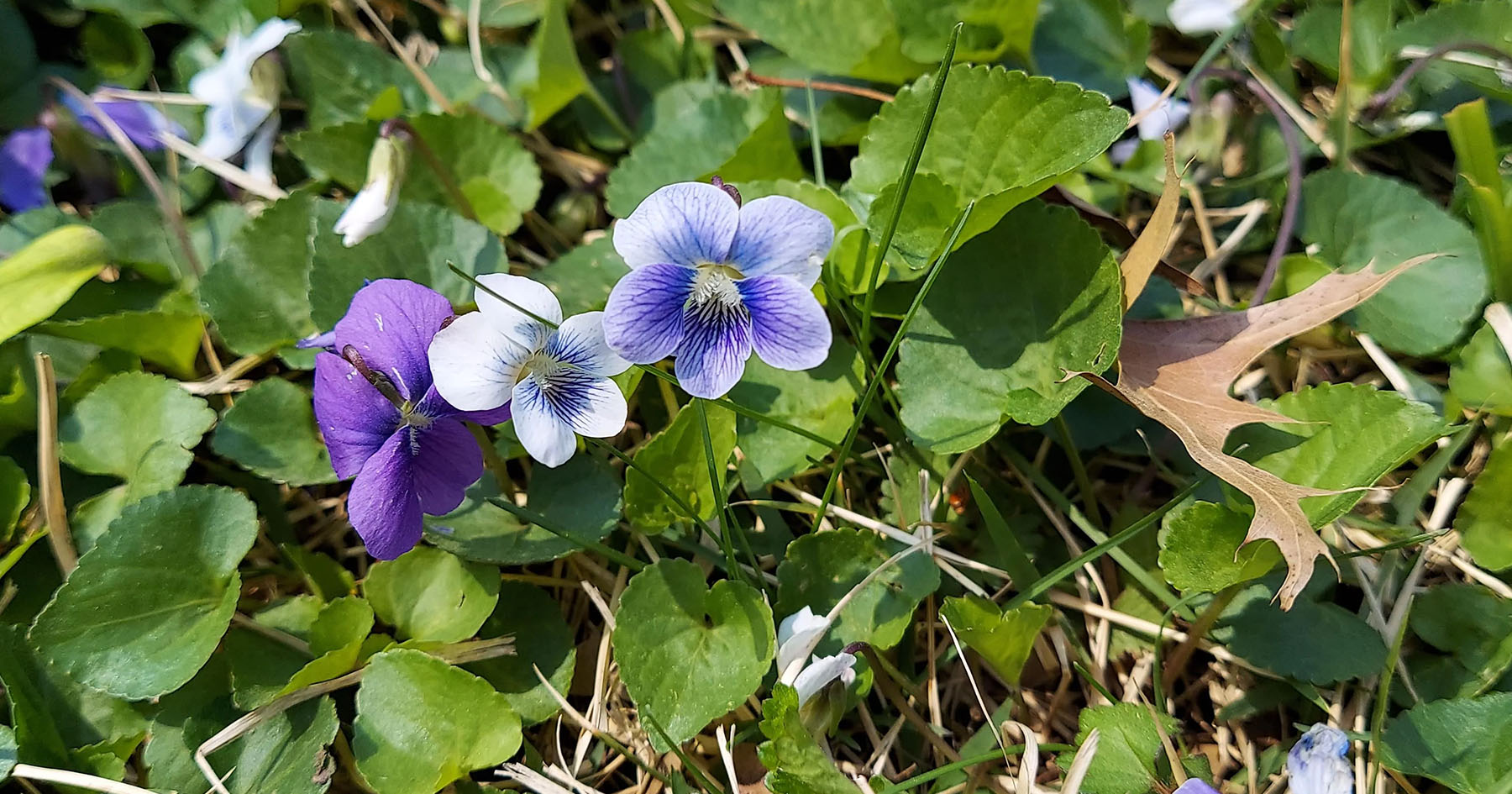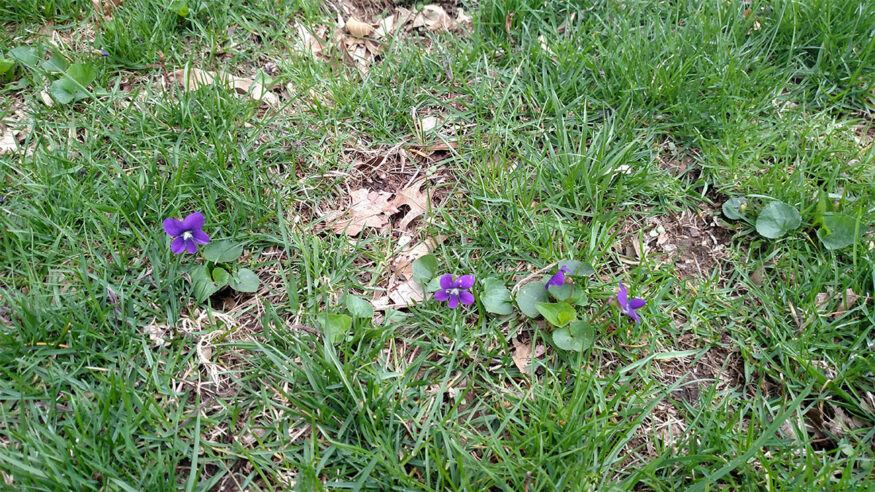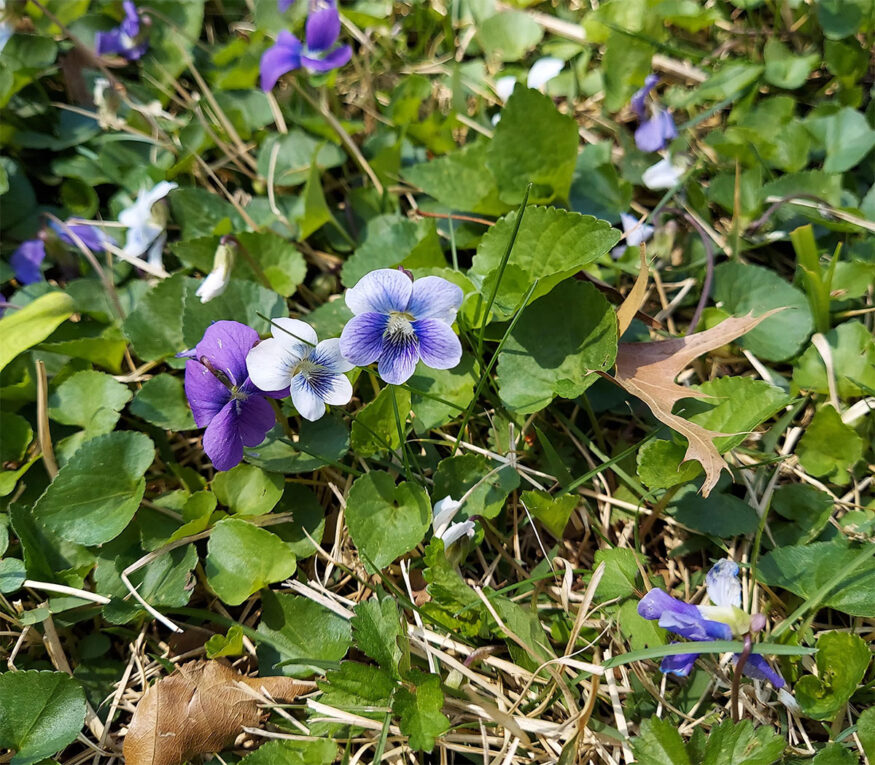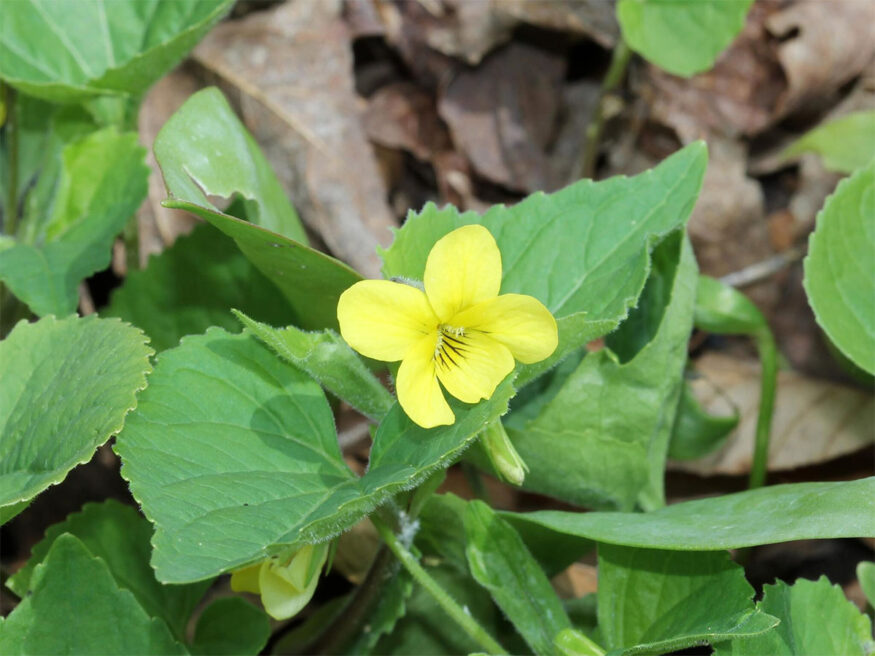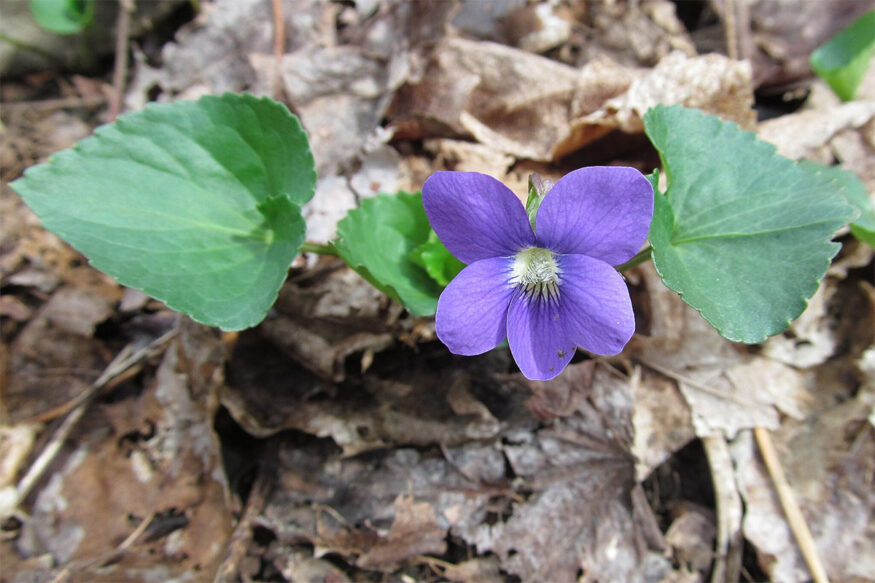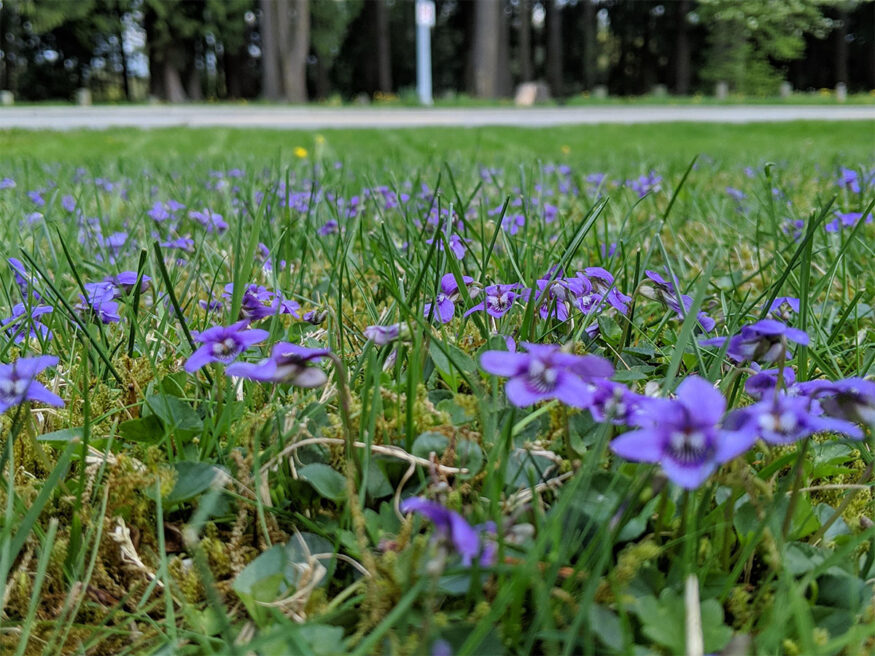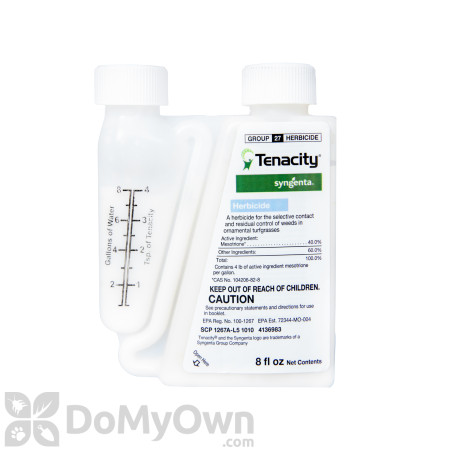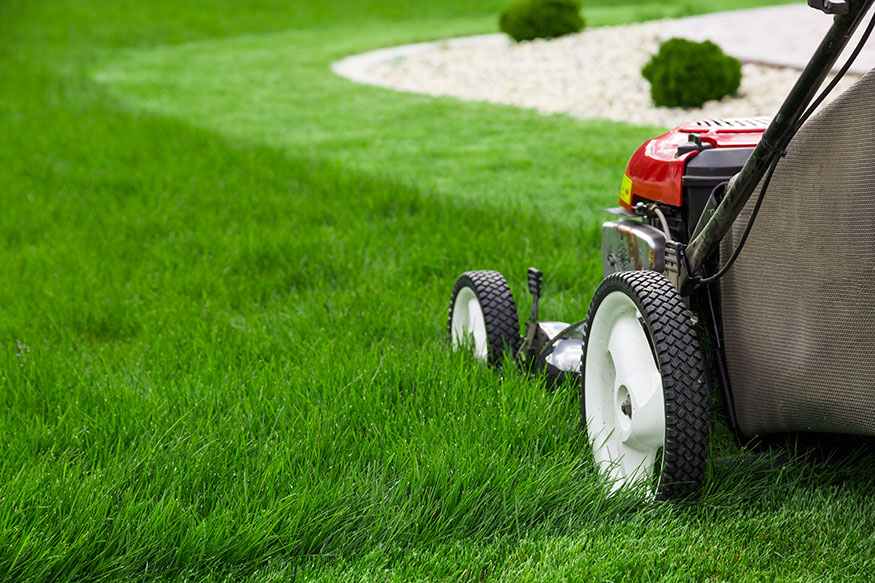Wild violets are an aggressive perennial weed that can invade your lawn if left unchecked, especially in damp, shady areas. They bloom in spring, featuring attractive purple, white, or yellow flowers with five petals, but their presence can lead to various challenges for maintaining a healthy lawn.
To get rid of wild violet weeds in your lawn the most effective way is to use a herbicide containing triclopyr or manually remove them.
But should you actually bother about removing them (there are benefits to having them around), and how do you stop them coming back? Let’s take a look in the rest of the article.
What Are Wild Violets
Classification and Characteristics
Wild violets are a type of plant that can be both a lovely wildflower and an invasive, aggressive weed.
Wild violet’s can be identified by:
- Small, colorful flowers that can be purple, white, or yellow
- Their distinctive heart-shaped leaves with serrated edges.
These plants have tuber-like roots and waxy leaves, which make them difficult to eliminate.
You might come across wild violets in your lawn or garden; while some people appreciate their beauty as a groundcover, others view them as a persistent and invasive nuisance. Their flowers are not only visually pleasing but also edible, offering various culinary uses.
Types of Wild Violets
There are several species within the Viola genus that are referred to as wild violets, such as Viola sororia, and Viola pubescens.
These species may vary slightly in appearance, particularly in flower color, but they all share the distinctive heart-shaped leaves and ability to thrive in various environments. Wild violets can grow in moist, fertile soils and persist in both full sun and shaded areas.
Keep a close eye on wild violets in your lawn or garden; their invasive nature can make them difficult to control if left unchecked. You can tackle these plants with proper techniques to eliminate them if you decide that they aren’t a welcome addition to your outdoor space.
Wild Violets and Your Lawn
Impact of Wild Violets
Wild violets are a type of weed that can grow in your lawn. These attractive, yet stubborn plants have purple or white flowers and thrive in shady areas.
Wild violets can quickly spread, especially in poorly maintained lawns, as they produce thick, branching rhizomes that give rise to new plants. Their strong root system, combined with their ability to self-seed, makes them difficult to control.
When Do They Appear
Wild violets typically appear in April and persist through the spring in northern regions.
Their flowers range in color from light blue to deep purple, and they often grow in shady parts of your lawn, where there is more moisture.
Regular watering can inadvertently encourage the growth of wild violets, so be mindful of your lawn’s watering schedule and conditions.
Should You Kill Wild Violets In Your Lawn?
Before you decide to wage war against wild violets, consider their ecological benefits. They serve as food for certain pollinators, and their flowers can add a dash of color to your lawn.
However, if you view them as an unwelcome intrusion, there are ways to eliminate them from your lawn and regain control.
Control and Elimination
Chemical Control
To control wild violets in your lawn, you can use herbicides containing triclopyr, which may require multiple applications.
Commonly used herbicides like Tenacity and 2-4 D can also be effective in treating these aggressive weeds.
Some people have also found Quinclorac-based herbicides such as Drive to be effective.
The best time to apply herbicide to wild violets is in fall, as this is when they are more likely to take the herbicide to their root system as they prepare for winter.
Remember to follow the directions to ensure you accidentally kill all your grass or other plants as well! Also be sure to wear the relevant protective equipment.

- Active Ingredient: Quinclorac
- Target Weeds: Barnyardgrass, Bindweed, Crabgrass (large & smooth), Clover, Dandelion, Daisy, Dollarweed, Foxtail, Kikuyugrass, Signalgrass, Speedwell, Torpedograss, and others

- Active Ingredient: Triclopyr
- Target Weeds: Black Medic, Bull Thistle, Clover, Dandelion, Ground Ivy, Kikuyugrass, Plantain, Ragweed, Wild Carrot, Wild Violet and others
How To Use Herbicides To Kill Wild Violets – Spot Treatment Method
Herbicides can be a highly effective solution when you need to rid your lawn of wild violets. Below is a step-by-step guide on how to properly and responsibly use herbicides for this purpose.
Opt for spot treating individual wild violets instead of indiscriminately spraying your entire lawn. This method allows you to accurately target the problematic plants, minimizing the dispersion of chemicals in your environment. A garden sprayer with a wand nozzle enables precision during the application.
1. Preparing the Herbicide
Create your weed-killing concoction by mixing a broad-spectrum weed killer in the garden sprayer as per the instructions provided on the label. Always remember to don the suggested protective gear to safeguard against any potential harm.
2. Improve Herbicide Adherence
Wild violets have waxy leaves that may repel the herbicide. To enhance the absorption, add a surfactant or a tablespoon of dish soap to your herbicide mixture. This concoction would ensure the herbicide clings to the leaves and doesn’t just roll away.
3. Herbicide Application
Now, begin spot treating individual wild violets. Ensure you apply the herbicide mixture generously to drench all the leaves of each plant. Avoid skin contact and inhalation of the herbicide mist, as these may lead to harmful effects.
4. Routine Observation
Keep a close eye on these treated plants over the next two to three weeks. As the herbicide begins to work its magic, you should notice the wild violets turning a telltale brown and eventually dying.
5. Disposal of Dead Plants
Once the wild violets have died out visibly, you can proceed to remove the wilted, brown leaves manually.
6. Consider Retreatment
Do not be dismayed if some stubborn plants survive the initial herbicide treatment. These hardy survivors might endure the winter and make a comeback in the spring. If this happens, simply treat the new growth with your herbicide mixture as necessary.
Thoroughly adhering to these measures will help you to effectively utilize herbicides while dealing with wild violet infestations in your lawn. Combined with careful application and observation, these steps promise to deliver the outcome you desire – a wild violet-free lawn!
Organic Solutions
For a more natural approach to control wild violets, hand-pulling really is the only real option. Just make sure that you remove the entire rhizome (roots) and any seeds to prevent regrowth.
How To Remove Wild Violets By Hand
One of the most effective, straightforward ways to eliminate wild violets from your lawn is by plucking them out by hand. This may seem like an old-fashioned technique, but it’s often the most dependable choice. Follow these simple steps:
1. Water The Surface
Start by equipping yourself with gardening gloves and dampening the area with a garden hose. Allow the water to seep into the soil for roughly thirty minutes. This crucial step creates a softer soil environment, making it much easier to pull out the plants.
2. Young Plant Removal
For the removal of young wild violets, carefully grasp the main stem near the soil line and pull straight up. Usually, these young sprouts have shallow root systems that allow for effortless extraction.
3. Dealing With Established Violets
If you’re dealing with larger, firmly established clumps of wild violets, employing a garden fork will help immensely. Begin by digging under the plant and loosening the surrounding soil. Once you can position the fork beneath the plant, leverage it to lift the violet out from underneath and remove as much of the root system as you can.
Remember, whether they’re young sprouts or established colonies, the objective here is to extract the wild violets together with their root systems. By following these straightforward steps, you’ll effectively rid your lawn of these pesky flowers, allowing your grass to flourish unfettered.
Differences Between Chemical and Organic Approaches
There are key differences between chemical and organic approaches in controlling wild violet weeds. Chemical herbicides are considered quicker in eliminating the weeds, however, they might pose risks if not used according to the label’s directions.
Some chemical herbicides are safe for pets once dry, such as Tenacity, but precautions should be taken to prevent pets from eating treated grass.
On the other hand, organic solutions may take longer to show results, but they are more environmentally friendly and can maintain the harmony of your lawn’s ecosystem. Combining both approaches, for example by using organic herbicides and hand-pulling, could increase the effectiveness of wild violet control without relying solely on chemicals.
Prevention Measures
Mowing and Watering
Maintaining a healthy, thick lawn is the best way to prevent weeds like wild violet from taking hold. Mow regularly and water your lawn sufficiently to encourage the development of a dense root system that makes it harder for violets to thrive.
Avoid Thatch and Soil Compaction
Deal with soil compaction by aerating and top-dressing your lawn when required. Thoroughly dethatch and aerate your lawn to limit competition and encourage healthy grass growth.
Use of Fertilizers
Provide your lawn with proper nutrients by fertilizing it regularly. This helps your grass grow thicker, which in turn limits the space available for wild violets to develop.
Also, ensure that the PH level of your soil is acceptable and amend the lawn soil as required.
Employing Pre-emergent Herbicides
In early spring, apply pre-emergent herbicides to prevent violet seeds from sprouting.
Look for products containing prodiamine, indaziflam, or dithiopyr and follow the label instructions carefully. Repeat applications may be necessary due to wild violets’ persistent root systems.
It is especially important to use a pre-emergent herbicide if you are recovering from a previous wild violet infestation as there will likely be seeds laying dormant in the ground ready to sprout at the right time.
Be sure to read the label of your chosen herbicide and wear the relevant protective equipment.
- The Anderson’s 0.48% Barricade Herbicide effectively prevents a variety of weeds without harming beneficial plants.
- This versatile weed control product can be used in various landscapes and inhibits weed seed germination and root growth.
- For optimal results, apply Andersons Barricade in early spring and fall, followed by watering, and choose from 18-lb. and 50-lb. bags to meet your needs.
Frequently Asked Questions
How can I organically remove wild violet weeds?
To get rid of wild violets organically, you can try using a mixture of one part white vinegar and four parts water in a sprayer. Apply this solution to the violets, focusing on the leaves, stems, and flowers to weaken and eventually kill the plant.
This method is not always effective and can take many applications to work.
Are wild violets poisonous to humans or pets?
Wild violets are not considered poisonous to humans or pets. In fact, the leaves and flowers are edible and have been used in traditional medicine and culinary dishes. However, it is always best to consult with a veterinarian if you have concerns about your pet consuming wild violets.
What product can eliminate violets without harming the grass?
To eliminate wild violets without harming your grass, try using Ortho Weedclear Lawn Weed Killer. This product is designed to specifically target broadleaf weeds, while keeping your grass healthy.
Should I pull or leave wild violets in my garden?
Whether you should pull or leave wild violets in your garden depends on your personal preference. Some gardeners appreciate the aesthetics of wild violets and may choose to let them grow, while others view them as an invasive weed that needs to be removed. Consider your garden’s overall design and maintenance goals when making this decision.
What plants look similar to wild violets?
Wild violets have distinctive heart-shaped leaves and flowers that can be purple, violet, blue, or white. Some plants that may look similar to wild violets include African violets, pansies, and violas. It’s important to closely examine the leaves, flowers, and other plant characteristics to properly identify wild violets.
